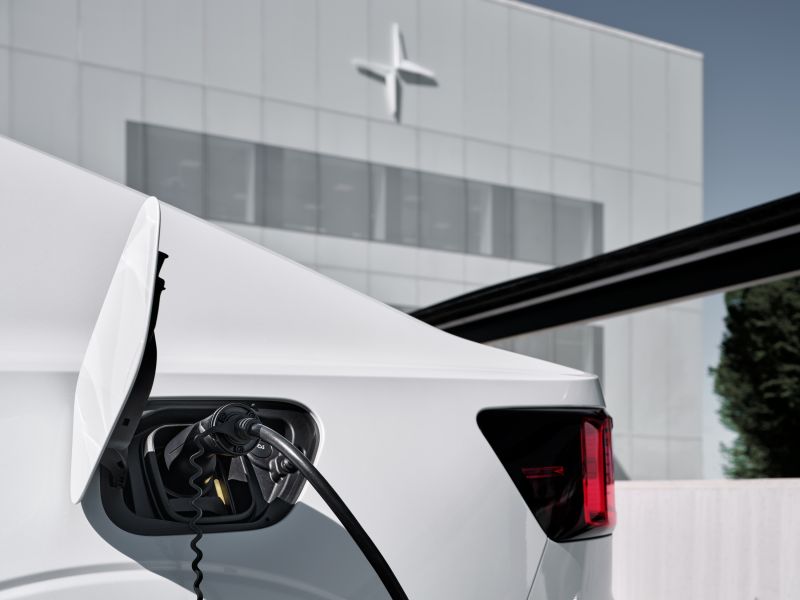Volvo's Electric Brand Polestar is Partnering in a Swedish Energy Project to Accelerate the Development of Vehicle-to-Grid Technology
【Summary】Volvo’s new electric vehicle brand Polestar is part of a new joint project with four other companies in Sweden to accelerate the development of Vehicle-to-X (V2X) technology, including Vehicle-to-Grid (V2G) and Vehicle-to-Home (V2H). The project is being supported by the Swedish Energy Agency.

In the future, the environmental benefits of having millions of EV on the road will be determined by how the energy is produced for keeping all of the vehicles charged.
The environmental benefits of a zero emissions electric car are somewhat diminished if EV charging stations rely on natural gas or coal-fired power plants for generating the additional electricity to keep millions of EVs charged on a daily basis.
However, automakers and stakeholders are beginning to study ways that EVs in the future can help support the grid with a source of sustainable energy, rather than simply take from it. A new project in Sweden is being launched to study the feasibility of using electric vehicles as a source of renewable energy, including for homes.
Volvo's new electric vehicle brand Polestar is part of a new joint project with four other companies in Sweden to accelerate the development of Vehicle-to-X (V2X) technology, including Vehicle-to-Grid (V2G) and Vehicle-to-Home (V2H).
The project is being supported by the Swedish Energy Agency. Joining Polestar in the project is Chalmers University of Technology, the Gothenburg energy grid supplier Göteborg Energi, charging solution provider CTEK and energy solution provider Ferroamp.
The study will last for the next 2 years and 9 months, Polestar said.
As part of the project, the five companies will build two V2X demonstration charging stations in Gothenburg. One will be located at Polestar's global headquarters and the other on the Chalmers University campus.
"This is exciting for us – we have been exploring this bidirectional technology for some time now and we want to bring it to life in our future products," said Polestar's Head of Research and Development, Hans Pehrson. "It gives our R&D team great pleasure to be involved in this project with such fantastic future potential."
Vehicle-to-X (vehicle-to-everything) refers to a network where all vehicles and infrastructure systems are interconnected with each other. It allows an electric vehicle's battery pack to act as a power source when plugged into the grid. If an EV is charged with green energy such as wind or solar, it will provide the grid with a source of clean energy.
"V2X will really revolutionise the future of power grids all over the world," said Pehrson. "I can imagine a world where thousands of electric vehicles, all plugged in to the grid, act as an important part of a fully renewable energy system. For example a V2H solution could maximise the storage of local green energy and provide back-up capacity for peak periods. This is a step towards a world without the need for coal or nuclear power plants."
Vehicle-to-Home (V2H) technology is using an EVs battery pack as an additional power source for a home, especially during periods of peak demand.
The feasibility of using millions of plugged in EVs to send power back to the grid when they are not being driven has not been fully explored, but the project with Polestar might help to get a better understanding of how it can be achieved, as well as how it might scale.
However the industry is not fully onboard yet on how useful this technology can become.
As a pioneer in the adoption of electric vehicles, Tesla Chief Executive Elon Musk has expressed doubts about the V2G technology as a sustainable or reliable source of power to support an electrical grid. During Tesla's Battery Day event in Sept 2020, Musk said "Vehicle-to-grid sounds good, but I think actually has a much lower utility than people think."
Musk believes that the extra energy from a Tesla vehicle can best be used to charge a Powerwall energy storage (which Tesla also sells) device attached to a customer's home.
Tesla's current home EV chargers are also not connected to the grid right now, so it will take a big investment on Tesla's part, or any other manufacturer of EVs, to further explore V2G of V2H technology.
The upcoming Polestar project in Sweden is a start.
-

Two Ford Crown Victorias Still Operating as Taxis in NYC
-

Mazda CEO's Opinion on EV Adoption in the U.S.
-

Hyundai's revolutionary powertrain design
-

Sustainability focus urged by Michelin Fleet Panel
-

BM Catalysts' UK Expansion
-

Warwick University's £12m funding for electric vehicle battery progress
-

Executive X Series: Unveiling the Powerful City/Vios Competitor
-

Hollywood couple defies expectations, showing affection after 20 years
- Hyundai to Launch Autonomous Ride-Hailing Service in South Korea
- Faraday Future Delays Launch of FF91 Electric SUV Again
- BMW i Ventures Invests in Vendia, a Next-Gen Blockchain Company Helping Businesses to Securely Share Data With Third Parties
- Volkswagen Group China Unveils its ‘Flying Tiger’ Electric Vertical Take-Off and Landing (eVTOL) Passenger Aircraft Prototype
- Tesla Raises Prices in the U.S. as Inflation Chips Away at its Profit Margins
- General Motors is Building a Coast-to-Coast DC Fast EV Charging Network in the U.S. in a New Partnership with Travel Center Operator Pilot Company
- The World’s First Level-4 Automated Parking Feature Developed by Mercedes-Benz and Bosch is Approved for Commercial Use
- Report Claims Nissan Leaf Will Be Discontinued by 2025
- Uber and its Technology Partner Aurora to Expand Autonomous Trucking Pilot in Texas
- Consumer Reports Survey Finds Roughly 28% of Respondents Don't Want to Buy an EV



















 About Us
About Us Contact Us
Contact Us Careers
Careers